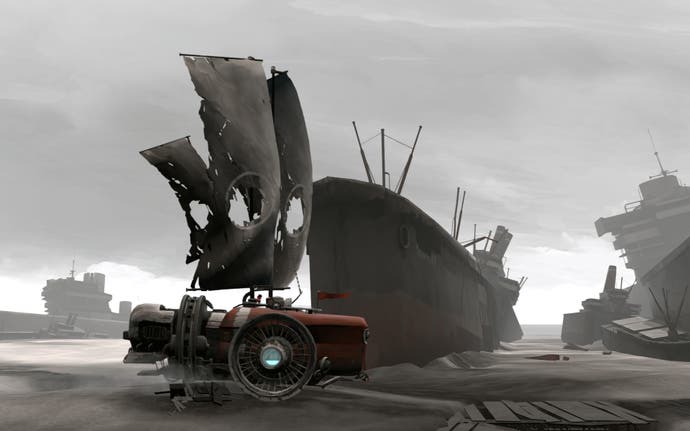Far: Lone Sails' solo journey is far from lonely
Travelling companion.
A moment of calm. The wind is doing the work, blowing my rickety vehicle along a flat stretch. With no need to be inside, repeating the frenetic cycle of feeding the engine, full-body-pushing the enormous button to send it roaring to life and venting steam to prevent it exploding from its own heat, I'm standing on the roof watching the world go by. It's quiet.
When I drop back down into the guts of the car, something's on fire.
So it goes in Far: Lone Sails. The game follows exactly one trip, and takes place almost entirely within its vehicle. It's not the reliable car that we use in our day-to-day lives, and it's not the obliging horse that we so often use to get around in video games. It's the complete opposite of fast travel. There are no objectives or quests where you're going or where you're coming from.
In centralising the journey, not the destination, developer Okomotive shifted focus to the method of travel itself. In doing so, it created a vehicle that's more than a tool for getting from place to place. It made a companion.
It's a rattly, quirky thing. Throughout the trip bits get added to the hull, piecemeal. It's scratched up and the sails are full of holes. But it's far from a bucket of bolts. Each new addition slots neatly into place, as though it was always there. Oftentimes its bright blue engine and rusty red hull are the only splashes of colour for miles around, its headlights casting a glow in front of you that cuts back the gloom even if only slightly. Its snub-nose is whale-like, cutting a path ahead as the milometer ticks ever upwards. It feels lively.

In many ways the game feels like one long escort mission. There is almost always something you need to be doing to coax your beleaguered craft onwards, and even when things are running smoothly you can't go far before hitting an obstacle that you can pass through yourself, but that you need to move out of the way of your chunky van.
But it's not frustrating. Despite travelling through a vast, often bleak world, you're always in or near a familiar space. Even though you leave your house at the beginning of the game, you have a home.
Several years ago I crossed Uganda in a van called Ssenga ("aunt"). The country is far from the unwelcoming expanse of Far: Lone Sails, but there are long rural stretches that feel similarly lonely. Ssenga, on the other hand, was almost identical to the game's vehicle. Constantly broken, getting from place to place was an ordeal that once resulted in five flat tyres in one day, one of which left us stranded in a national park with no phone reception for hours until we could get moving again. And yet when constantly somewhere unfamiliar, it was comforting to return to the same seat, to know that our suitcases were behind us, piled underneath a mountain of mangoes, avocados, and tiny sweet bananas.
The game captures this same feeling, particularly when it comes to the tiny personal touches that can make any space feel homey. When you leave your actual house, you take the mailbox with you as a memento. Mine sat in pride of place on the roof, like a figurehead on a ship. But I also picked up things from the road. The ever-hungry engine needs constant fuel, so most items don't get to hang around for long. But when the going is good you might find a stack of books, or, in one shining moment, a flower pot, which can be used to make the space yours. I hung the flower over the bed, along with a lamp that I found. I rarely even went into that part of the interior, being so occupied with the engine, but having it there made the whole place feel mine.

The vehicle itself also feels tactile in ways that become familiar. Pushing the engine start button requires effort, your tiny character visible struggling against its weight. But it eventually clicks in with a deeply satisfying noise, and you're freed to bounce off onto another task. And that does usually require bouncing - the interior of the vehicle is a tiny platforming challenge that, once mastered, makes the methodical, cyclical tasks feel like an effortless dance; a tango between machine and driver.
Even when things are chaotic, you have shelter and a promise of escape. At one point, hail began pelting down from the dark sky, while some failing of mine led to a chain reaction of fires inside. I tried to put them out, not realising that the hose requires the same energy as the engine, which was empty. I tried to remedy that with a barrel that turned out to be explosive, causing yet more fire. It was a mess. But when it was over there was another shining moment of calm. The craft and I had pulled through, together.
By interspersing moments of hardship with moments of serenity, the game ensures that they don't become frustrating or boring respectively. Instead, overcoming every obstacle feels like a hard-won success and every breather feels like a well-deserved rest. And all of the tribulations and victories are shared with your erstwhile vehicle companion.
Neither you nor the ship could make this journey alone. The game presents a partnership, a home away from home, and a comforting space within a strange world, bringing a sense of warmth to a story that could easily have been far more bleak.

